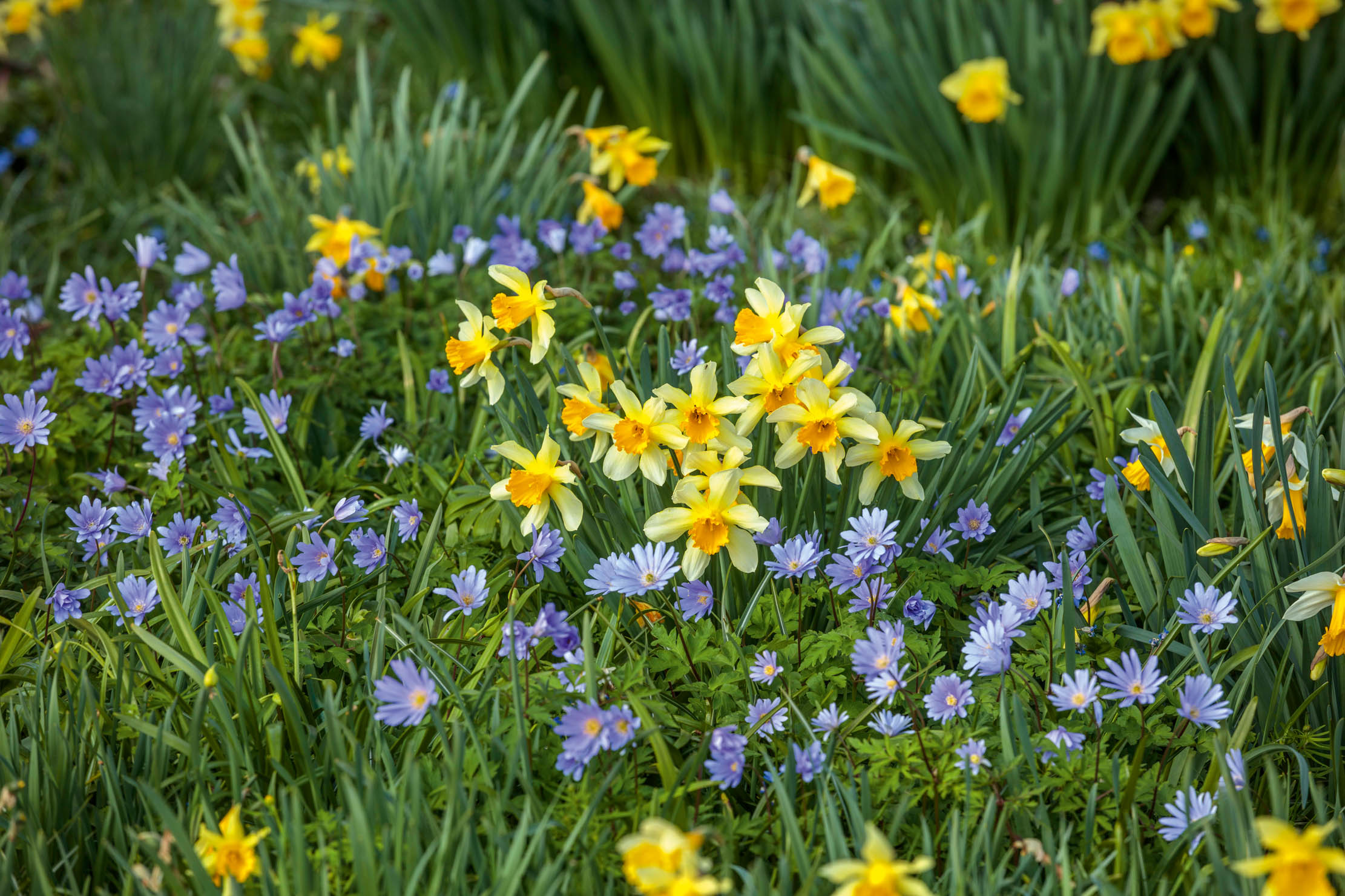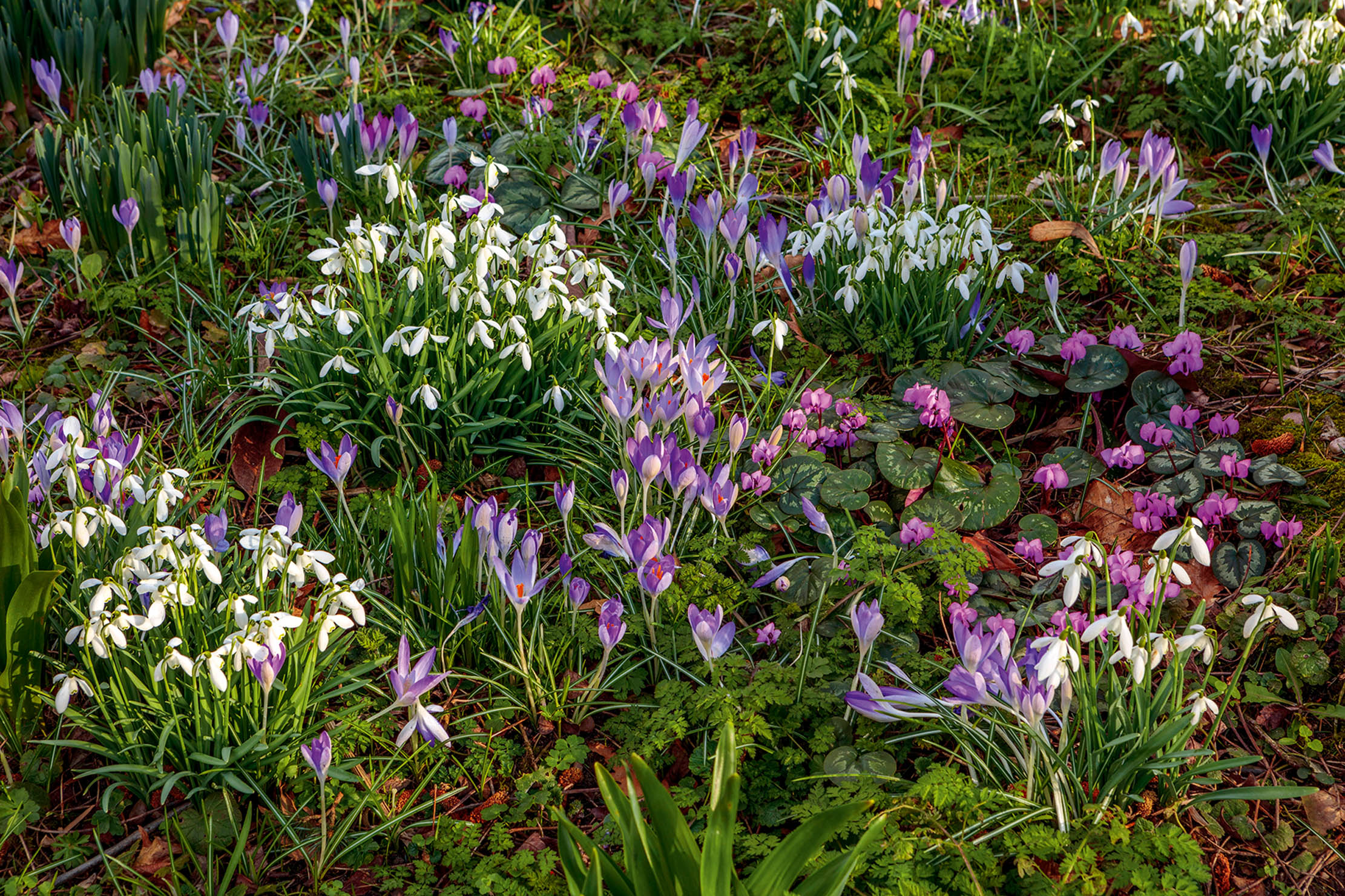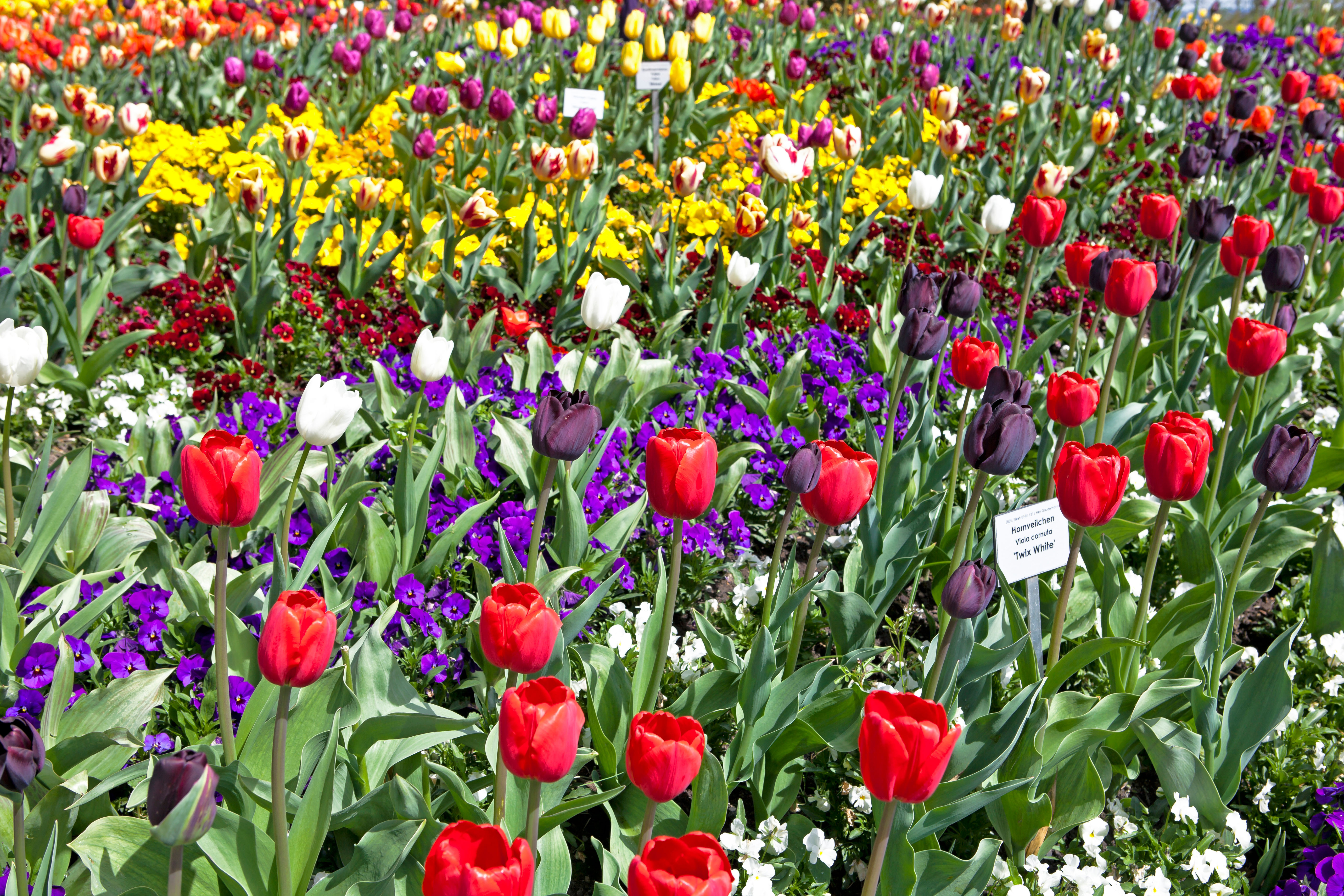The Wild Garden at Doddington Hall: Bright-bulb moments
Sweeps of spring bulbs scatter the lawns of The Wild Garden at Doddington Hall — the Lincolnshire home of Mr and Mrs James Birch — in what appears to be an entirely natural show. Yet it is, in fact, a carefully curated selection that flowers in three distinct phases, says Tilly Ware. Photographs by Clive Nichols.

Perched on the westerly edge of Lincolnshire, Doddington Hall has remained in family ownership since it was built in 1600. An exquisite 1707 copper engraving of the estate by Johannes Kipp illustrates a cluster of outbuildings, including gatehouse and church, alongside tightly-controlled geometric gardens: a chessboard of crisp parterres, regimented orchards and cruciform paths. Today, swinging into the drive, that formality seems to be intact. A pair of topiary unicorns rear in the East Garden, where vast yew domes echo the cupolas on the Elizabethan building. On the opposite side, the walled West Garden retains neatly-clipped box-edged beds, crammed in summer with iris and roses.
Step through the western gate, however, on a brisk February morning and the atmosphere is entirely different. Tremendous sweeps of spring bulbs spangle the lawns, as luxurious as the bejewelled portraits in the brick, three-storey house itself, designed by Robert Smythson. The spacing and colour shading is so harmonious that it seems to be entirely wild and natural. A stone-flagged path flanked by yew columns is lapped on either side by continuous waves of tissue-thin, silvery Crocus tommasinianus.

‘My parents initially planted a few cultivars, such as Crocus ‘Barr’s Purple’ and ‘Whitewell Purple’, but they reverted to species,’ explains Antony Jarvis, who inherited Doddington in the 1970s and has gardened here for more than 50 years. His eldest daughter, Claire, and her husband, James Birch, took over the estate in 2007; Mr Jarvis now lives in a house attached to the walled garden, his spade permanently propped up by the back door. These measureless drifts of flowers that appear to have existed for centuries are all his work.
When Mr Jarvis first took over the garden, the inventory proved sparse: those few crocus, clumps of Galanthus nivalis, a handful of Cyclamen hederifolium and a splash of Erythronium denscanis. He worked steadily through the Wild Garden, to the north-west near the parkland and woods, ‘splitting snowdrops and spreading them, creating patches landscaped among trees and open grass’.

In the 1870s, this was set out as a pleasure ground, furnished with cedars of Lebanon, cork oaks and various rhododendrons; large-leaved trees such as magnolias and catalpas followed in the 1930s. Using a Finnish tool known as a pottiputki, originally designed for planting forest-tree seedlings and with a satchel of freshly divided snowdrops on his shoulder, Mr Jarvis would manage a rate of 500 bulbs an hour.
Luckily, the tommies spread of their own accord, the profligate seed travelling on the mower. Cyclamen coum came next: Mr Jarvis bought 100 plants and, knowing they could be fussy, trialled them in a range of sites. They all thrived, so another 500 were planted among the increasing drifts of snowdrops and crocus.

Now, after years of carefully lifting and bulking up the seedlings, they number in the tens of thousands. This trinity of snowdrop, crocus and cyclamen flows unstoppably in all directions: under helter-skelter branches of gnarly sweet chestnuts, hopping alongside mown paths, rippling between Hamamelis x intermedia and Daphne bholua and swarming down avenues of cherry trees. It is mesmerising, particularly the infinitely subtle variation in all three species. The recurved, snubby-nosed cyclamen petals range from deep magenta to baby’s-breath pink to a rosy white. En masse and backlit by winter sun, the crocus form one shimmering, almost translucent gauzy mist; on close inspection, each reveals its individual and intricate whiskery stippling on the inside of the goblet. Metallic snowdrop leaves and the marbled pewter in cyclamen foliage are beautiful partners, heightening the sensation of hazy delicacy.
Exquisite houses, the beauty of Nature, and how to get the most from your life, straight to your inbox.
None of the plants is more than 4in high. The Crocus tommasinianus and C. chrysanthus grown at Doddington are lighter limbed, more prone to variation and generally more elegant than the bossier Dutch crocus, C. vernus. Most of the C. chrysanthus cultivars that Mr Jarvis tried were snuffed out by voles, but a few survivors have intermarried and produced beautiful, unexpected children. Any that dare to be too garish are dispatched.
The second act in Mr Jarvis’s spring show is heralded by Lent lilies, early-flowering hybrid daffodils and Erythronium ‘Pagoda’. For the finale, there are pools of soft, understated Victorian daffodils and Narcissus poeticus var. recurvus, with fritillaries and Camassia leichtlinii in the wetter areas near the stream. The historic daffodils have hybridised so many times that they cannot be truly identified. Mr Jarvis marshalls them into groups of a single type and colour, letting greenish-white gently spread into pale primrose-yellow and digging up interlopers that spoil the effect. ‘I’m very free with moving things,’ he admits. ‘Any time you can see them is a good time.’

Many were taken to the kitchen-garden stock beds when flowering and transplanted at a later date. Brassy Narcissus ‘King Alfred’ has been banished; the graceful Triandrus N. ‘Ice Wings’ introduced. The small wild daffodil, Narcissus pseudonarcissus, scatters itself about in a spotted fashion, moving the eye along. Some beauties Mr Jarvis hoped to grow—such as Tulipa clusiana, Iris reticulata and Eranthis hyemalis—failed to take off, but that may be a boon. The impact of these hypnotic swathes depends on a colossal number of a few species. Too many shapes and shades and the enchantment is broken.
Crucially, this area does not try to be all things in all seasons: as soon as the narcissi leaves turn yellow, all is cut down and mown weekly until the last possible moment in December. There are no hungry large grasses or floral meadows competing for water and fertility. The bulbs can sit quietly all summer, well fed and well rested, drawing up strength for their next astonishing performance.
How to naturalise bulbs in grass
- For a wilder-looking bulb meadow, stick to the three ‘S’s: small, species, scattered. Divide spring into three sections — early, mid, late — and plan the successions accordingly. Most spring bulbs (except camassia and some fritillaries) are natives of dry, rocky places and will not appreciate a sprinkler or an irrigation system.
- Crocus leaves develop at a fast rate once the flowers have finished and give sustenance to the new corm, which develops on top of the old one, like a stack of cushions. The new corm must grow to a certain size for it to flower the following year.
- Mice have always been the enemy of the crocus: a 1614 nursery catalogue engraving shows a mouse happily tucking into a corm. They are hungriest and more likely to attack newly planted corms in autumn, rather than when they are in active growth. If small thieves are a problem, try planting five corms in 5in pots, place in a cold frame and then plant out when the first green shoots appear.
- The natural habitats of Cyclamen coum are the beech and pine woods of the Caucasus, Turkey and Syria, but, with good drainage, they can romp away in open grass, their blooms appearing all the way from Christmas to March. C. coum grows more slowly and in a more straggly way than C. hederifolium, without forming the tall, dense lumps of foliage. It’s better not to mix the two, as the autumn-flowering species is a tougher beast and will crowd out its quieter spring cousin.

Credit: Alamy
Alan Titchmarsh: The best time of year to plant tulips
Alan Titchmars on planting tulips - and avoiding the grind of removing and storing bulbs every year.

Alan Titchmarsh: The 'Hollywood A-listers' of the plant world are fussy, flouncy — and totally irresistible
Alan Titchmarsh waxes lyrical about the benefits of bulbs, and why disposing of them year on year might not be

Credit: Alamy Stock Photo
Alan Titchmarsh on bulbs: Why they're my 'firework' plants – sit back and watch them go
Alan Titchmarsh talks about his love of bulbs, which ones not to bother with, and the difference between a gardener
Tilly Ware is a gardener and gardening writer.